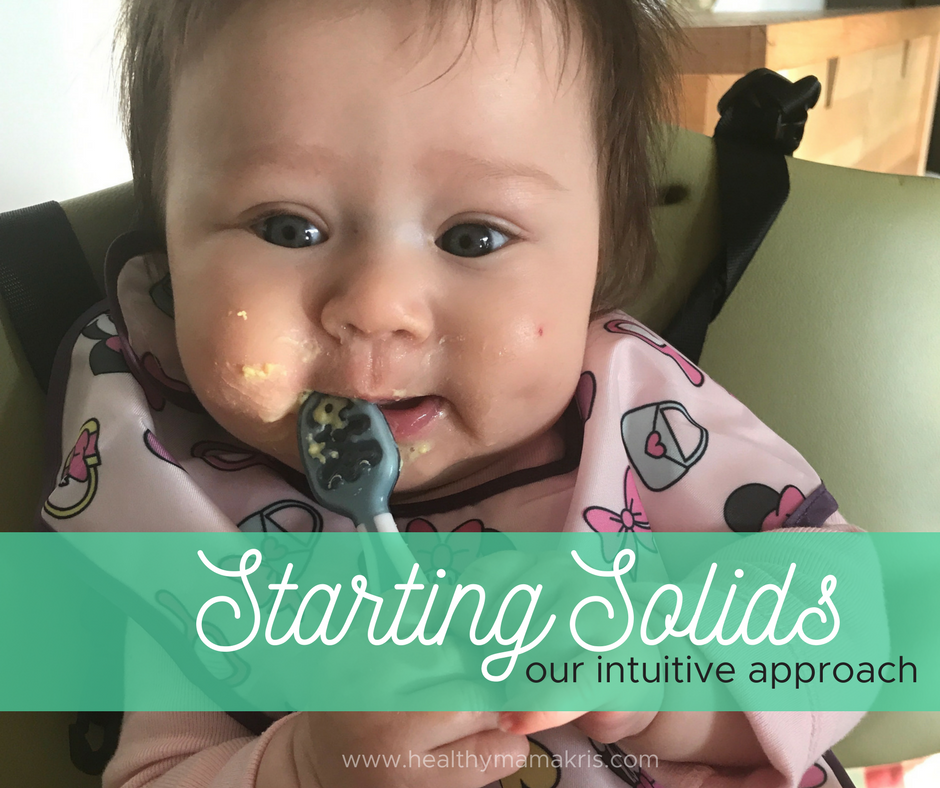Before I begin, it’s important to note I am not a medical doctor; nor am I formally trained in infant nutrition. Though it is a deep passion of mine, I highly encourage you to discuss with your pediatrician before implementing any changes.

Wren has struggled with feeding since the beginning. She struggled to gain weight early on, and it was months of trial and error, dealing with thrush, LOTS of pumping and bottle feeding (thank the Lord for Como Tomo bottles!!) until we finally got into a nursing groove around four months.
When she hadn’t gained much at all (only 6 oz in an entire month), and the doctor suggested starting some real food, I knew in my heart of hearts she wasn’t ready.
But, when five months rolled around and she started showing some serious readiness signs, I was torn. Adding extra nutrients to her diet would be a good thing for her; but I wanted to consider digestive health and readiness, first. We know that iron and zinc levels drop significantly around 6 months and breast milk is simply not enough. The current recommendations by the AAP and the WHO also state that six months (never before four months, which I agree with wholeheartedly- and the research backs this up) is the ideal time to start solid foods. With Sage, we just followed the recommendations to a tee and went from there. Four years later and far more educated, this time I decided to dig into the research as to why.
The Evidence: Obesity, Mom’s Concerns and Displacement of Breastmilk
Why six months over four, or five? What I found was interesting. The majority of the research points to six months being ideal due to evidence pointing to early feeding (before 4-6 months) and obesity later on in life (it seems as though, there is no clear evidence after four months: https://www.ncbi.nlm.nih.gov/pmc/articles/PMC5691224/). However, the AAP and WHO both also recommend self-feeding and following baby’s cues (responsive feeding) to avoid over-feeding (a common problem with parent-led spoon feeding) and helping baby develop self awareness and hunger and fullness cues, which I consider MOST important in terms of preventing obesity and weight-related problems later on.
The WHO also states prolonging the duration of lactational amenorrhea and accelerating weight loss as a reason for waiting to complementary feed until six months (this clearly has nothing to do with the baby himself). They do state that preterm infants might require foods earlier, due to lack of adequate iron stores around time of birth. They also state that “growth is generally not improved by complementary feeding before six months even under optimal conditions” and that “complementary foods introduced before six months tend to displace breast milk”; a valid point. They continue, “After six months of age, however, it becomes increasingly difficult for breastfed infants to meet their nutrient needs from human milk alone (WHO/UNICEF, 1998). Furthermore, most infants are developmentally ready for other foods at about six months (Naylor and Morrow, 2001).”
Gut Health
In terms of gut health, what I found was even more fascinating. There is a common thought process in the natural food world that holding off on feeding is due to gut permeability. However, it is not entirely true that the gut is thoroughly “open” before six months; in fact, it starts to close soon after birth, and continues to throughout the first year- the most notable change happening when solid feeding happens:
European Society for Pediatric Gastroenterology, Hepatology, and Nutrition (ESPGHN; PDF):
“The available data suggest that both renal function and gastrointestinal function are sufficiently mature to metabolise nutrients from complementary foods by the age of 4 months. With respect to gastrointestinal function, it is known that exposure to solids and the transition from a high-fat to a high-carbohydrate diet is associated with hormonal responses (eg, insulin, adrenal hormones) that result in adaptation of digestive functions to the nature of the ingested foods, by increasing the maturation rate of some enzymatic functions and/or activities. Thus, to a large degree gastrointestinal maturation is driven by the foods ingested.”
There is some evidence waiting until six months of age may offer some protection against gastroenteritis (an acute gut condition), however, most studies find no difference in risk of GI infection whether babies start solids between 4 and 6 months or after 6 months (see references)
Allergies
When it comes to allergies, studies actually point to EARLY introduction of allergenic foods (which is a much different thought process than was recommended for years, including in my early University nutrition training 10 years ago). In fact, two different studies on peanuts and egg whites pointed to babies benefitting from introduction of these highly allergenic foods by 4-6 months; after 9 or 10 months the instance of allergy went up dramatically.
Even more important than all of the conflicting studies and statistics is readiness cues (which I’ll talk about in a whole other post!). Both the AAP and the WHO as well as other professional bodies recommend waiting until baby is displaying READINESS SIGNS: which is exactly what I decided to do.
Two weeks, in the grand scheme of things, is a blip in time. Yet at five months I resisted, despite my sweet little one screaming and grabbing at our food, and then her mouth, when we ate; nearly-sitting (she sat independently for 1 minute + at 5.5 months) and losing the tongue-thrust reflex entirely (we’ve been giving her a tiny spoon of coconut oil to combat thrush since 11 weeks) and at 5.5 months couldn’t take it any longer. What’s two weeks? I knew she was ready. And so, we began.
So what was her first food?
The same as Sage’s— pastured egg yolk; and simply because it was available, good quality and we were eating eggs with dinner, too. Egg yolk has it’s benefits (like choline for brain health, b-vitamins and healthy, easily absorbable fats) and drawbacks (the iron in it is not bioavailable, and this is one of the first things babies need). But I gave it to her knowing more iron-rich foods would follow shortly.

No rice cereal? I could write a whole blog post on this one, but no- and we don’t plan on doing rice cereal at all. We’re choosing to start with whole, nutrient dense foods, because I believe (and the research shows) when a baby is ready to eat and is fed nutrient rich foods, fortified foods are unnecessary. But more on that in the future.
We did egg yolks on Tuesday, and then on Thursday (she ate more, then) and when she didn’t have a reaction, we decided to hand her a piece of grass-fed steak on Saturday night. She LOVED it (understatement of the year). She grabbed it right away and sucked it and smiled and gummed on it. It was so cool to watch, and my instincts were confirmed that she was ready and willing to eat solid food.
From there, we’ve been introducing a new food every couple of days, going slowly at first, watching for potential reactions and loving every minute of it. We’re only two weeks in, and this is (not surprisingly) one of my favorite stages yet.
I’ll talk more about our approach and baby led weaning vs. purees, but we’ve been (and plan to continue) feeding with a combination of self-feeding (steak, steamed carrots and apples) and soft spooned foods (egg yolk; mashed avocado), practicing responsive feeding to introduce principals of intuitive eating early.
So do I recommend starting solids at 4 months, 5 months, or 6 months? As the research backs up, there is only one thing for certain; babies are not ready for solids before four months. From there, the evidence gets a bit more fuzzy.
Our early-ish start to solids aligns exactly with what I recommend to the moms I work with; watch the baby, not the calendar. For some, starting at 6.5 or 7 months is ideal because babies simply aren’t ready. Mine was ready, with gusto, at 5.5 and I’m confident in our decision to start (our pediatrician is on board too, by the way- this is important!). How YOU start solids with your baby will be determinant on what YOU (and your healthcare practitioner) consider readiness. Just like adults, there is no one-size-fits-all.

References:
Agostoni, C. et al. Complementary feeding: a commentary by the ESPGHAN Committee on Nutrition. J. Pediatr. Gastroenterol. Nutr. 46, 99–110 (2008).
Cohen, R. J., Brown, K. H., Dewey, K. G., Canahuati, J. & Landa Rivera, L. Effects of age of introduction of complementary foods on infant breast milk intake, total energy intake, and growth: a randomised intervention study in Honduras. The Lancet 344, 288–293 (1994).
Dewey, K. G., Cohen, R. J., Brown, K. H. & Rivera, L. L. Age of introduction of complementary foods and growth of term, low-birth-weight, breast-fed infants: a randomized intervention study in Honduras. Am. J. Clin. Nutr. 69, 679–686 (1999).
Catassi C1, Bonucci A, Coppa GV, Carlucci A, Giorgi PL. J Pediatr Gastroenterol Nutr. 1995 Nov;21(4):383-6. Intestinal permeability changes during the first month: effect of natural versus artificial feeding.
van Elburg RM1, Uil JJ, Kokke FT, Mulder AM, van de Broek WG, Mulder CJ, Heymans HS. J Pediatr Gastroenterol Nutr. 1995 Feb;20(2):184-8.Repeatability of the sugar-absorption test, using lactulose and mannitol, for measuring intestinal permeability for sugars.
https://www.nytimes.com/2013/03/25/health/many-babies-fed-solid-food-too-soon-cdc-finds.html
https://scienceofmom.com/2015/02/25/what-to-do-about-babies-and-peanuts-new-study-finds-early-exposure-can-prevent-allergy/#comments
Leave a Reply Cancel reply
5-day series: how to get started with meal prep for easier meals
free email series
©️ 2025 Kristin Dovbniak for Healthy Mama Kris | Template by Maya Palmer Designs | Privacy Policy | Terms
